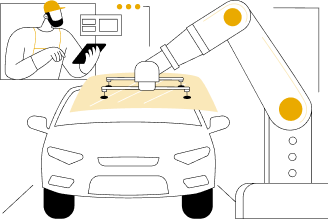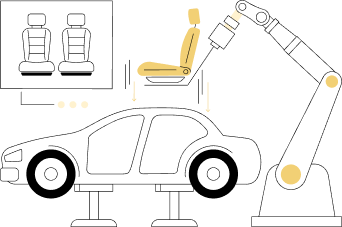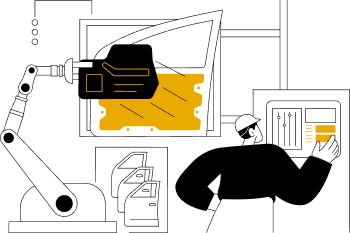- Benefits of IoT in the Automotive Industry
- Predictive Maintenance
- Connected Vehicles
- In-Vehicle Infotainment
- Smart Infrastructure
- Fleet Management
- Use Cases of IoT in the Automotive Industry
- Autonomous Vehicles
- Driver and Fleet Management
- Real-Time Vehicle Telematics
- Software Updates
- Cellular Vehicle To Everything (CV2X)
- Monitor the Driver’s Condition
- Real Examples of Automotive Companies Using IoT-Based Solutions
- Tesla
- Ford
- BMW
- Addressing the Challenges of Connected Cars: Effective Solutions and Strategies
- Network Reliability
- Data Management and Integration
- Security and Privacy Concerns
- Cost of Implementation
- Future of Automotive IoT in 2025 and Beyond
- How Appinventiv Can Help Leverage Automotive IoT
- FAQs
- Q. How is IoT used in automotive?
- Q. What is the impact of IoT on vehicles?
- Q. What is the future scope of IoT in the automobile industry?
To stay ahead in this competitive industry and meet customers’ expectations, automobile companies are increasingly utilizing the power of automotive IoT (Internet of Things). The term refers to a complex chain of devices, such as cameras, sensors, GPS trackers, etc., connected to the cloud and providing real-time data, assisting in the effective optimization of the car manufacturing process. Also, automotive IoT facilitates advanced vehicle management capabilities, improved transportation efficiency, and a superior driving experience, defining the future vision of autonomous vehicles.
Automotive IoT has opened new avenues for automakers and buyers worldwide. From connected devices for cars to automated vehicles, the applications of IoT in the automobile industry have made a deep dent in the sector.
In short, the possibilities that IoT can bring to the automotive sector are immense, revolutionizing the way people commute and interact with their vehicles. According to Statista, the estimated money invested in automotive IoT will reach $740 billion by 2025.
Tap into this growing market trend with Appinventiv
Benefits of IoT in the Automotive Industry
The Internet of Things allows for easier, faster, and more secure communication and data distribution between computers and connected devices, benefiting industries worldwide, and the automotive sector is no exception.

Let’s discuss in detail how IoT is benefiting the automotive industry.
Predictive Maintenance
When it comes to vehicle maintenance, there are two approaches – preventive and predictive. And predictive maintenance always goes a step ahead of the preventive. With automotive IoT, one can monitor the status of cars and all connected devices in real-time and predict when the vehicles require maintenance, preventing any serious issue from occurring or resolving a pertinent one before it turns critical.
Connected Vehicles
One of the most remarkable benefits of Automotive IoT is CV2X (cellular vehicle to everything), connecting smart transport systems and vehicles with each other. With the incorporation of IoT in the automobile industry, vehicles can share relevant information, like location, route, speed, etc., in real-time, managing traffic flow and reducing the risk of collisions or accidents.

In-Vehicle Infotainment
Besides preventing accidents and maintaining vehicles, IoT-enabled in-vehicle infotainment systems entertain drivers and passengers throughout the journey. It provides services like navigation, music streaming, hands-free calling, voice assistance, etc.
Even though in-vehicle infotainment systems work only when connected to Wi-Fi or a smartphone with an internet connection, automakers are working to make it run autonomously in the future. In fact, Apple and Google have launched CarPlay and Android Auto (their car-centric operating systems) that offer in-car streaming, facilitating passengers to watch movies, listen to music, and play vehicles while traveling.
Smart Infrastructure
The benefits of IoT in automotive manufacturing are not just limited to improved vehicles and reduced accident rates. Roads and infrastructure play an integral role in the automobile sector. And with IoT and AI applications in place, drivers can access smart infrastructure, adding a better driving experience, improved road safety, hassle-free parking management, and reduced collision rates.
Fleet Management
The automotive IoT has brought a big revolution in fleet management. Accordingly, today’s trucks and other vehicles are integrated with location tracking, weight measurement, and other sensor-based systems, facilitating drivers and fleet managers alike.
The sensory data gathered from such trucks are stored in a cloud and then processed and conceptualized into a visual format. A fleet manager can efficiently utilize this data to monitor different parameters regarding fleet management.
[Also Read: How much does it cost to develop a fleet management software?]
IoT in the automotive industry offers enormous benefits, making cars safer, smarter, more efficient, and more interconnected. Identifying these benefits and tapping into the potential can be the ultimate game-changers for automotive manufacturers, suppliers, drivers, and passengers alike.
[Also Read: Advanced Fleet Management Technologies You Must Implement in Business]
Use Cases of IoT in the Automotive Industry
IoT in the automotive industry has unlocked limitless possibilities, revolutionizing the sector while reducing cost and increasing quality. With IoT applications in the automotive industry, the automakers are creating cutting-edge technologies, like predictive maintenance solutions, Advanced Driver-Assistance Systems (ADAS), navigation & telematics solutions, in-vehicle infotainment systems, CV2X (cellular vehicle to everything), and many more.
Also Read: IoT in Logistics and Supply Chain – Benefits, Use Cases & Challenges
Let’s discuss the top 6 real-time IoT applications in the automotive industry:

Autonomous Vehicles
Autonomous vehicles have been a hot potato in the automotive industry. Many automobile companies are constantly working to develop fully autonomous cars zooming around the roads. Even though industry leaders like BMW, Tesla, Waymo, etc. are already leveraging AI and IoT trends in the automotive industry to develop self-driving cars, a fully driverless vehicle is still a vision.
However, these industry giants have manufactured IoT-infused semi-autonomous vehicles that assist drivers with driving, parking, braking, and lane-changing activities, reducing the risk of human error and making driving a safer experience.

Driver and Fleet Management
Other automotive IoT use cases are fleet management systems, providing fleet operators multiple advantages. IoT devices help fleet operators monitor and manage the fleets of vehicles, like tracking fuel consultation, optimizing routes, and scheduling maintenance, to improve efficiency and reduce costs. Additionally, automotive IoT shares statistics on driver performance and health, detects drowsiness, and sends idle alarms.
Furthermore, IoT sensors give signals and set off warning alarms for coolant temperature, low battery, engine maintenance, etc. With IoT in vehicles, fleet managers can automate various procedures like trip planning, product delivery, and superior service, resulting in improved customer experience.
Real-Time Vehicle Telematics
A significant use of IoT in the automobile industry is the cloud-connected IoT boxes linked to telematics devices that offer real-time data on driver health and vehicle status. When IoT and telematics come together, it helps track the movement, position, conditions, and behavior of vehicles within a fleet.

By utilizing the power of vehicle telematics, the car owner can monitor his vehicle even remotely. The benefits of vehicle telematics include remote vehicle speed limit controls, remote access to vehicle operation data, and vehicle collision notifications to third parties and emergency responders.
Software Updates
Automotive software updates in the IoT-integrated vehicles helps to improve locking mechanisms, advance the in-car entertainment experience, reinforce cyber security, improve navigation, and other features. It is one of the most significant applications of IoT in the automobile industry, which improves both vehicles’ safety and performance as well as the driving experience.
Cellular Vehicle To Everything (CV2X)
A cellular vehicle-to-everything (CV2X) is one of the most remarkable IoT use cases in the automotive industry, which helps connect cars with one another. Connected cars allow faster data transmission and enhanced vehicle communication. Depending on the vehicle’s connection with different objects, the CV2X can be segmented into four sub-categories:

Vehicle to Vehicle (V2V)
The V2V connection allows nearby vehicles to exchange data related to the location, speed, and dynamics of vehicles. V2V plays a major role in preventing accidents and facilitating the easy movement of emergency vehicles, such as fire trucks and ambulances, through traffic.
Vehicle to Infrastructure (V2I)
V2I connection is a network of vehicles and road infrastructures that consists of traffic lights, toll booths, and lane markings. V2I helps manage traffic flow and avoid getting trapped at petrol pumps and toll booths in long queues.
Vehicle to Pedestrians (V2P)
By using a mobile app, pedestrians can connect with the CV2X network, which facilitates them to locate nearby taxis and track the estimated arrival time for public transit. Additionally, pedestrians can connect with the application with a pedestrian walking system and can change traffic signals to easily cross a road without the fear of accidents.
Vehicle to Network (V2N)
Vehicle-to-network refers to the effective connection of the weather forecast department and Intelligent Transport System (ITM) to alert drivers about changes in weather conditions or an accident on the road. Additionally, the driver can connect vehicles with smartphones to use voice commands for operating music systems and GPS while driving.
Monitor the Driver’s Condition
IoT in vehicles analyzes car sensors to collect data about the physical and psychological conditions of the driver. This data helps detect the driving pattern and behavior of the driver, which can be further processed to provide extra support and security to the drivers. Also, the data can be used for insurance purposes. Some companies even incorporate IoT-enabled active wellness seats for drivers that monitor the heart rate and breathing rhythm, alerting drivers for feasible fatigue or nap and reducing the risk of accidents.
The applications of IoT have inspired innovation in just every aspect of the automobile industry, making it the driving force for the next generation of vehicles. With IoT in vehicles, you can monitor and manage vehicle statistics with only one swipe on the app. These real examples of IoT in manufacturing are creating space for more extensive adoption and entering a new phase of revolution where all automobiles will be autonomous soon.
Also Read: Demystifying IIOT – 10 Applications and Use Cases across Industries
Want to know how?
Real Examples of Automotive Companies Using IoT-Based Solutions
Automotive companies are increasingly adopting IoT-based solutions to improve driver safety, vehicle performance, and the driving experience while optimizing the entire manufacturing process. There are multiple applications of IoT in automobile companies. Let’s discover some real examples of automotive companies using IoT-based solutions:
![]()
Tesla
Elon Musk’s “Tesla Motors” is a leading electric vehicle manufacturer that has truly leveraged the power of IoT in its cars. Tesla manufacturers integrate IoT sensors in the vehicles, which help collect data based on drivers’ behavior patterns, battery status, vehicle performance, etc. This data is transmitted to Tesla’s servers, where IT experts analyze it to find out any issue and solve it in real-time before it gets critical.
Also Read: Cost to Build an Advanced Driver Assistance System Like Tesla Autopilot
Ford
Ford is another leading automotive company that uses IoT-based solutions to improve the driving experience and vehicle quality. The factories of Ford have IoT sensors that track every stage of the manufacturing process, such as machinery, inventory, and production.
Ford CEO and president Mark Fields has been utilizing IoT solutions to develop autonomous cars for more than a decade. GoDrive and GoPark, (a predictive parking system that directs users to a suitable parking space) and FordPass (a hub for connected car services, such as car sharing, remote locking, vehicle location, etc.) are some other remarkable applications of IoT in Ford service range.
BMW
BMW uses IoT-based solutions to improve vehicle performance and advance the driving experience. In addition, BMW connects its ConnectedDrive services with IFTTT
(If This Then That ) and IoT smart technology, which helps enhance vehicle connectivity.
From supply chain management, predictive maintenance, and operational efficiency to inventory optimizations, BMW leverages the power of IoT to its fullest. In short, BMW has adopted every aspect of IoT in creating the Connected Cars that have revolutionized an individual’s driving experience in the Smart and Connected World.
Addressing the Challenges of Connected Cars: Effective Solutions and Strategies
Connected cars face several significant challenges, from ensuring robust network reliability to managing vast amounts of data securely. However, implementing the right solution can overcome such challenges. Let’s have a look at those.
Network Reliability
Unreliable or weak network connections can disrupt essential services like real-time navigation and updates, affecting the driving experience.
Solution: Strengthen network infrastructure with broader coverage and adopt technologies such as 5G to enhance connectivity. Incorporate offline capabilities for critical functions to ensure continuous operation during network interruptions.
Data Management and Integration
The vast volume of data generated by connected cars can overwhelm systems and complicate integration across platforms.
Solution: Use advanced data analytics and cloud-based storage to handle and process large data sets efficiently. Standardize data formats and implement interoperable platforms to facilitate smoother integration.
Security and Privacy Concerns
Connected cars are vulnerable to cybersecurity threats such as hacking and data breaches, which can compromise user safety and privacy.
Solution: Implement strong encryption, conduct regular security updates, and use intrusion detection systems to safeguard against cyberattacks. Ensure compliance with data protection regulations and perform frequent security audits to enhance privacy.
Cost of Implementation
The high cost of integrating advanced IoT technology into vehicles can be a significant barrier for manufacturers.
Solution: Reduce costs by leveraging economies of scale and forming strategic partnerships with technology providers. Focus on scalable solutions and prioritize features that deliver the most value to manage expenses effectively.
Future of Automotive IoT in 2025 and Beyond
IoT in the automotive industry has unlocked new value for all involved parties and is continuing to evolve in the coming years. It is reshaping the way we look at the automotive industry, which actively works with self-steering, smart parking, AI-driven acceleration, and braking in Tesla vehicles.
Not only Tesla but even some of the latest models of BMW, Mercedes-Benz, and Audi are adopting IoT technologies and setting examples for automotive IoT to support their forward-thinking action plans for fully autonomous vehicles.
These advancements made by automobile companies in vehicles have the potential to revolutionize the industry, making driving safer, smarter, more efficient, and more sustainable than ever before.
Here are some potential developments of IoT we can expect to see in 2025 and beyond:
- The integration of IoT in vehicles will lead the way to the adoption of fully autonomous vehicles.
- Since IoT sensors collect data about the driver’s preferred seating position, music choice, temperature settings, etc., it helps provide more personalized driving experiences to the individual who is in the driving seat. The level of personalization is expected to grow in the coming years.
- The use of automotive IoT also helps optimize engine performance, reduce vehicle emissions, and improve overall sustainability. In the future, it is expected to provide even greater efficiency in transport management.
- As IoT is increasingly integrated into vehicles, there will be a growing need for enhanced cybersecurity measures to protect sensitive data from cyber theft.
Related Article: How to Ensure Cybersecurity in the Age of IoT
IoT in the automobile sector has a wide scope, significantly changing how we interact with vehicles. With IoT in vehicles, we can expect continued innovation in more advanced analytics, increased automation, greater connectivity, and fully autonomous vehicles, revolutionizing the industry in the coming years.
How Appinventiv Can Help Leverage Automotive IoT
The application of IoT in the automotive industry is increasing with each passing day. The days are at hand when innovative automobiles and fully autonomous vehicles will take center stage in the automobile sector.
It is why legacy automotive enterprises and startups strive to create more connected devices to extend their IoT capabilities. Appinventiv, a leading automotive software development company, can help you realize this forward-thinking approach of building IoT channels and growing exponentially with its intuitive 5G and IoT technology for automobiles.
Get in touch with our efficient team of IoT engineers to make your automotive IoT development project successful and accelerate your digital transformation journey. Being a leading IoT development company, we carry core competencies in creating breakthrough IoT solutions for global clients that help you thrive in the automobile industry.
Apart from helping you leverage IoT at its true potential in the automotive industry, we also develop cutting-edge IoT solutions across various sectors like healthcare, retail, manufacturing, etc. Altogether, we can help you capitalize on automotive IoT solutions and exceed user expectations.
FAQs
Q. How is IoT used in automotive?
A. The use cases of IoT in the automotive industry are worth remarkable for fleet management, autonomous vehicles, and smart parking. Also, automotive IoT monitors and manages various performance metrics, such as brake wear, engine health, and tire pressure. Additionally, IoT sensors help collect data, which can be further used to improve vehicle efficiency, safety, and overall performance.
Q. What is the impact of IoT on vehicles?
A. The impact of IoT on vehicles is influential, enabling them to connect with Wi-Fi and other vehicles on the road. This high level of interconnection leads to improved vehicle performance, enhanced driver experiences, increased safety, and greater efficiency. Additionally, automotive IoT is the driving force for developing autonomous vehicles that can revolutionize how we drive and interact with our vehicles.
Q. What is the future scope of IoT in the automobile industry?
A. With continued technology advancements and the adoption of IoT devices, the future of IoT in the automobile industry seems to be vast and bright. Automotive IoT applications lead to improved vehicle performance, greater efficiency, better driver experiences, and increased safety. In the future, we can expect to see more innovative use cases of IoT in vehicles, such as advanced analytics, increased automation, greater connectivity, fully autonomous vehicles, and so on, leading to safer, more efficient, and more sustainable transportation.



Developing an IoT-Based Smart Water Management System - Key Benefits, Applications and Process
Think about this: by 2050, the global water demand is set to shoot up by over 50%. That's a lot of water, and frankly, the world needs to be smarter about its use. As a business leader, the strategies you implement today will greatly impact your company's and environment’s future, particularly in terms of sustainability…

Exploring IoT in Telecommunication - Use Cases, Benefits, Challenges, and Strategic Implementation
Telecom is the foundation of modern-day connectivity, supporting the communication networks that keep the world linked. But with the growing dependency of always being on and connected, led by the rapid pace of technological advancement, including 5G deployment, requires telecom operators to adapt quickly. With trillions of connected devices set to enter the digital space…

Top 10 Use Cases and Benefits of IoT Energy Management Changing the Power Industry
The escalating demand for energy consumption worldwide is projected to reach around 800 exajoules by 2050, a big jump from over 600 exajoules in 2019. This fastest-growing global energy use is throwing a major curveball - prioritizing smart energy for waste management. In this pursuit, the rise of the Internet of Things (IoT) offers a…


















